Related Research Articles
In cell biology, an organelle is a specialized subunit, usually within a cell, that has a specific function. The name organelle comes from the idea that these structures are parts of cells, as organs are to the body, hence organelle, the suffix -elle being a diminutive. Organelles are either separately enclosed within their own lipid bilayers or are spatially distinct functional units without a surrounding lipid bilayer. Although most organelles are functional units within cells, some function units that extend outside of cells are often termed organelles, such as cilia, the flagellum and archaellum, and the trichocyst.

In continuum mechanics, stress is a physical quantity. It is a quantity that describes the magnitude of forces that cause deformation. Stress is defined as force per unit area. When an object is pulled apart by a force it will cause elongation which is also known as deformation, like the stretching of an elastic band, it is called tensile stress. But, when the forces result in the compression of an object, it is called compressive stress. It results when forces like tension or compression act on a body. The greater this force and the smaller the cross-sectional area of the body on which it acts, the greater the stress. Therefore, stress is measured in newton per square meter (N/m2) or pascal (Pa).
Structural analysis is a branch of Solid Mechanics which uses simplified models for solids like bars, beams and shells for engineering decision making. Its main objective is to determine the effect of loads on the physical structures and their components. In contrast to theory of elasticity, the models used in structure analysis are often differential equations in one spatial variable. Structures subject to this type of analysis include all that must withstand loads, such as buildings, bridges, aircraft and ships. Structural analysis uses ideas from applied mechanics, materials science and applied mathematics to compute a structure's deformations, internal forces, stresses, support reactions, velocity, accelerations, and stability. The results of the analysis are used to verify a structure's fitness for use, often precluding physical tests. Structural analysis is thus a key part of the engineering design of structures.
Ultrafiltration (UF) is a variety of membrane filtration in which forces such as pressure or concentration gradients lead to a separation through a semipermeable membrane. Suspended solids and solutes of high molecular weight are retained in the so-called retentate, while water and low molecular weight solutes pass through the membrane in the permeate (filtrate). This separation process is used in industry and research for purifying and concentrating macromolecular (103–106 Da) solutions, especially protein solutions.
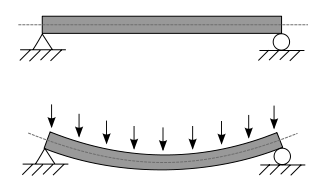
A beam is a structural element that primarily resists loads applied laterally to the beam's axis. Its mode of deflection is primarily by bending. The loads applied to the beam result in reaction forces at the beam's support points. The total effect of all the forces acting on the beam is to produce shear forces and bending moments within the beams, that in turn induce internal stresses, strains and deflections of the beam. Beams are characterized by their manner of support, profile, equilibrium conditions, length, and their material.
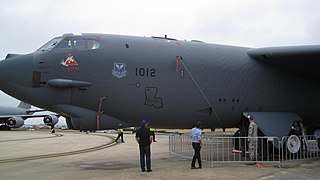
In structural engineering, buckling is the sudden change in shape (deformation) of a structural component under load, such as the bowing of a column under compression or the wrinkling of a plate under shear. If a structure is subjected to a gradually increasing load, when the load reaches a critical level, a member may suddenly change shape and the structure and component is said to have buckled. Euler's critical load and Johnson's parabolic formula are used to determine the buckling stress in slender columns.
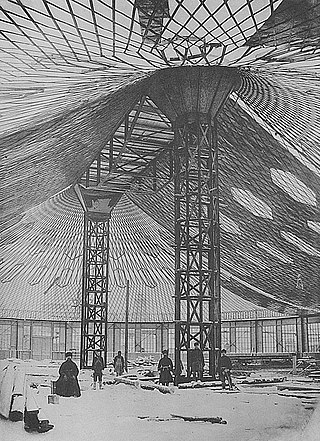
A tensile structure is a construction of elements carrying only tension and no compression or bending. The term tensile should not be confused with tensegrity, which is a structural form with both tension and compression elements. Tensile structures are the most common type of thin-shell structures.
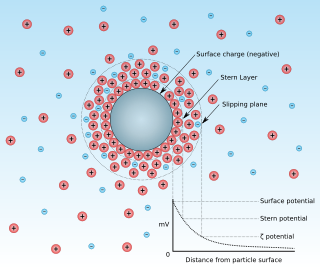
Zeta potential is the electrical potential at the slipping plane. This plane is the interface which separates mobile fluid from fluid that remains attached to the surface.

In applied mechanics, bending characterizes the behavior of a slender structural element subjected to an external load applied perpendicularly to a longitudinal axis of the element.
The finite element method (FEM) is a powerful technique originally developed for numerical solution of complex problems in structural mechanics, and it remains the method of choice for complex systems. In the FEM, the structural system is modeled by a set of appropriate finite elements interconnected at discrete points called nodes. Elements may have physical properties such as thickness, coefficient of thermal expansion, density, Young's modulus, shear modulus and Poisson's ratio.

A sandwich-structured composite is a special class of composite materials that is fabricated by attaching two thin but stiff skins to a lightweight but thick core. The core material is normally low strength material, but its higher thickness provides the sandwich composite with high bending stiffness with overall low density.

Structural mechanics or Mechanics of structures is the computation of deformations, deflections, and internal forces or stresses within structures, either for design or for performance evaluation of existing structures. It is one subset of structural analysis. Structural mechanics analysis needs input data such as structural loads, the structure's geometric representation and support conditions, and the materials' properties. Output quantities may include support reactions, stresses and displacements. Advanced structural mechanics may include the effects of stability and non-linear behaviors.
The elastic membrane analogy, also known as the soap-film analogy, was first published by pioneering aerodynamicist Ludwig Prandtl in 1903. It describes the stress distribution on a long bar in torsion. The cross section of the bar is constant along its length, and need not be circular. The differential equation that governs the stress distribution on the bar in torsion is of the same form as the equation governing the shape of a membrane under differential pressure. Therefore, in order to discover the stress distribution on the bar, all one has to do is cut the shape of the cross section out of a piece of wood, cover it with a soap film, and apply a differential pressure across it. Then the slope of the soap film at any area of the cross section is directly proportional to the stress in the bar at the same point on its cross section.
Lipid bilayer mechanics is the study of the physical material properties of lipid bilayers, classifying bilayer behavior with stress and strain rather than biochemical interactions. Local point deformations such as membrane protein interactions are typically modelled with the complex theory of biological liquid crystals but the mechanical properties of a homogeneous bilayer are often characterized in terms of only three mechanical elastic moduli: the area expansion modulus Ka, a bending modulus Kb and an edge energy . For fluid bilayers the shear modulus is by definition zero, as the free rearrangement of molecules within plane means that the structure will not support shear stresses. These mechanical properties affect several membrane-mediated biological processes. In particular, the values of Ka and Kb affect the ability of proteins and small molecules to insert into the bilayer. Bilayer mechanical properties have also been shown to alter the function of mechanically activated ion channels.

Roark's Formulas for Stress and Strain was first published in 1938 and the most current ninth edition was published in March 2020.
A plate is a structural element which is characterized by a three-dimensional solid whose thickness is very small when compared with other dimensions.
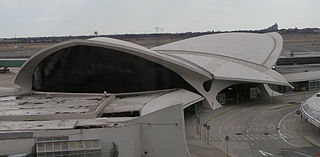
A shell is a type of structural element which is characterized by its geometry, being a three-dimensional solid whose thickness is very small when compared with other dimensions, and in structural terms, by the stress resultants calculated in the middle plane displaying components which are both coplanar and normal to the surface. Essentially, a shell can be derived from a plate by two means: by initially forming the middle surface as a singly or doubly curved surface, and by applying loads which are coplanar to a plate's plane which generate significant stresses.
Stress resultants are simplified representations of the stress state in structural elements such as beams, plates, or shells. The geometry of typical structural elements allows the internal stress state to be simplified because of the existence of a "thickness'" direction in which the size of the element is much smaller than in other directions. As a consequence the three traction components that vary from point to point in a cross-section can be replaced with a set of resultant forces and resultant moments. These are the stress resultants that may be used to determine the detailed stress state in the structural element. A three-dimensional problem can then be reduced to a one-dimensional problem or a two-dimensional problem.
This glossary of structural engineering terms pertains specifically to structural engineering and its sub-disciplines. Please see glossary of engineering for a broad overview of the major concepts of engineering.
Variational Asymptotic Method (VAM) is a powerful mathematical approach to simplify the process of finding stationary points for a described functional by taking an advantage of small parameters. VAM is the synergy of variational principles and asymptotic approaches, variational principles are applied to the defined functional as well as the asymptotes are applied to the same functional instead of applying on differential equations due to its less prone to errors. This methodology is applicable for whole range of physics problems, where the problem has to be defined in a variational form and should be able to identify the small parameters within the problem definition. In other words, VAM can be applicable where the functional is so complex in determining the stationary points either by analytical or by computationally expensive numerical analysis with an advantage of small parameters. Thus, approximate stationary points in the functional can be utilized to obtain the original functional.
References
- ↑ Wilhelm Flügge, Stresses in Shells (1973) 2nd edition, Preface, p. iv. ISBN 978-3-642-88291-3. Originally published in German as Statik und Dynamik der Schalen (1937).